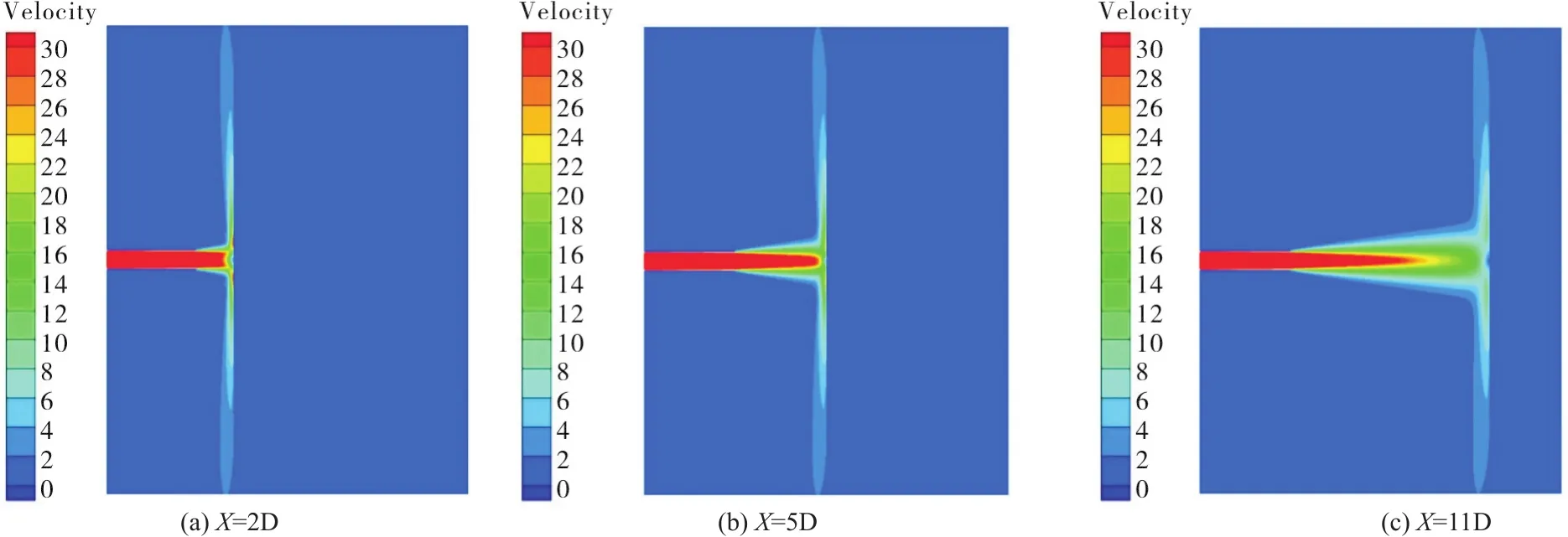Prediction of Noise Directivity of An Impinging Jet Using LES and Acoustic Analogy Method*
2019-07-23XinLiuJunlongXieQingXieMiaoWang
Xin Liu Jun-long Xie Qing Xie Miao Wang
(School of Energy and Power Engineering,Huazhong University of Science﹠Technology,China)
Abstract:The predictions of noise directivity of an impinging jet on the flat plate are carried out using the large eddysimulation (LES) and the Ffowcs-Williams and Hawkings (FW-H) acoustic analogy. Firstly, flow field of the proposedmodel is simulated and analyzed with different impinging distances under a certain impinging velocity. Secondly, soundpressure level (SPL) of different noise monitoring points are calculated under a range of impinging distances andvarious impinging velocities. Finally, combined with numerical result of the flow field, noise directivity of theimpinging jet is analyzed. It is indicated that main noise sources consist of the dipole source generated by pressurefluctuation on the plate surface and the quadrupole source generated by the turbulent jet. In addition, the impingingvelocity and the impinging distance have a significant effect on the regularity of noise directivity.
Keywords:Noise Directivity, Impinging Jet, Large Eddy Simulation,FW-HAcousticAnalogy
Nomenclature
D diameter of the nozzle
0 Introduction
Impinging jets are encountered in many industrial applications such as ventilation,aerospace,chemical equipment and impingement cooling[1].Suppression of the noise generated by these jets is of great fundamental and practical interest.Powel[2]analyzed the feedback mechanism of classical low-speed edge tones and studied properties of the sound sources in a low-speed impinging jet.Dhamanekar[3]presented extensive acoustic measurements on jets impinging on surfaces of various surface roughness values.Krothapalli[4]studied the flow field and noise characteristics of a supersonic jet impinging on a ground plane.Tsutsumi[5]studied the mechanism of acoustic radiation from supersonic jets impinging to inclined flat plates by experiment and numerical simulation.This type of acoustic generation is important for estimating and minimizing the acoustic loading of launch vehicle at lift-off.Lyrintzis[6]proposed a three-dimensional turbulent flow and studied the acoustic field of a supersonic jet impinging on a solid plate computationally using the ANSYS Fluent.He showed the effect of the inclination angle on sound pressure level spectra and overall sound pressure level directivities.Yao et al.[7]reported the interaction of shocks and vortices in a highly under expanded supersonic jet impinging on a large plate using the large-eddy simulation.In various research methods,large eddy simulation(LES)method has been widely used in theoretical and applied studies of flow field and noise characteristics of an impinging jet[8-11].
In the turbomachinery industry,impinging jets are applied to cool high-temperature components of the gas turbine,such as combustion chambers,blades,tail pipes,etc.Most of the researches focus on the heat transfer characteristics of the impinging jets.However,there is less attention to the noise characteristics of the impinging cooling.In this paper,flow field of impinging jet and far-field acoustic transformation are studied by large eddy simulation(LES)with Kinetic-Energy Transport(KET)subgrid-scale model and Ffowcs Williams and Hawkings(FW-H)acoustic analogy.We aim at establishing a suitable numerical method to predict the noise directivity of impinging jet on a flat plate.
1 Computational Method
1.1 Large eddy simulation(LES)
Time-accurate solutions of the flow-field variables can be obtained by large eddy simulation(LES).In the LES,the flow variables are decomposed into large-and subgrid-scale components through the filter function.Large-scale components are calculated directly and subgrid-scale components are parameterized.The instantaneous fluid variables can be defined as:

wherefis a generalized variable;is the large-scale fluid variable;f'is the subgrid-scale fluid variable;G(xi)is the filter function.xiandare the spatial coordinate and the filtered spatial coordinate,respectively.For incompressible fluids,governing equations of LES are defined as:
whereτijis the subgrid-scale stress which indicates that the subgrid-scale variables act on the large-scale ones and must be modeled.In order to study the acoustical properties of impinging jets more accurately,we adopt the Kinetic-Energy Transport(KET)subgrid-scale model in this paper[12].Governing equations of the KET model are given by:

whereksgsis the turbulent kinetic energy andμtis the turbulent viscosity.The value ofCkis determined by the flow state.
1.2 Ffowcs williams-hawkings acoustic analogy
A method based on the Ffowcs-Williams and Hawkings(FW-H)formulation is applied in ANSYS Fluent for the acoustic predictions.The method adopts the most general form of Lighthill's acoustic analogy,and is capable of predicting noise generated by equivalent acoustic sources.The FW-H formulation can be written as the following equation:

where

p'is the sound pressure at far field,c is the sound velocity,u is the fluid velocity,v is the body surface velocity,n is the normal vector pointing into the fluid,δ(f)is Heaviside function,H(f)is Dirac delta function,Tijis the Lighthill stress tensor.For a Stokesian fluid,Pijis the compressive stress tensor defined as:

The solution of FW-H equation can be written as the following:

where the Mach number vectorMrrelates to the motion of the integration surface:Mr=vi/c.
1.3 Numerical model
Fig.1 shows the numerical model of an impinging jet on a flat plate.The jet device is a cylindrical nozzle.The diameter of the nozzle(D)is 5mm and the length(L)is 25mm.The flat plate is circular.The diameter of the plate is 80mm.The distance between the plate and the nozzle(X)is the impinging distance.The computational domain is a cylinder.The diameter of cross section is 125mm and the length is 100mm.The whole numerical model is rotational symmetric.

Fig.1 Numerical model of an impinging jet on a flat plate
1.4 Mesh generation and boundary conditions
Structured mesh is applied to mesh generation.The computational domain is divided into several parts.Local mesh refinement is deployed in the jet segment.The present grid configuration of the nozzle consists of a symmetric O-grid block and gradually stretches up to the far-field regions.In Fig.2,one can see the detail view of computational mesh in the cross section of the model.The total mesh number is 2.2×106.
The boundary condition for the nozzle inlet is velocityinlet.The boundary of the computational domain is equivalent to the far field boundary.However,pressure far-field boundary condition is available only for compressible flows.Then pressure outlet/pressure inlet boundary conditions are applied in the present work.The left boundary of the computational domain is pressure-inlet.The other boundaries of the computational domain are pressure-outlet.The boundary conditions for the nozzle and flat plate are wall boundary.
1.5 Simulation method
Steady flow field is obtained by standard k-ω model as the initial field of LES.SGS model of LES in this paper is the Kinetic-Energy Transport model.The SIMPLE scheme is used in pressure-velocity coupling.PRESTO spatial discretization is applied to the pressure equation and the bounded central differencing format is applied to the momentum equation.Time step size is 2.5×10-5s according to the noise frequency range recognized by the human ear and the number of time steps is 10 000.
The simulation software used in this paper is ANSYS Fluent.The transient flow field accurately near the noise source is obtained by LES.Then noise characteristics of the impinging jet are calculated by acoustic analogy model.From the noise source to the receiver,the noise propagation is obtained by solving the acoustic wave equation.
2 Results and Discussion
2.1 Flow-field analysis
Fig.3 shows the three-dimensional streamline diagram of the flow field with X=5D.The impinging velocity is 30m/s.The flow field of impinging jet is divided into three regions:free jet region,stagnation flow region and wall jet region.In the free jet region,a part of fluid keeps the initial velocity and decreases with the development of free jet,forming the velocity core area.And the flow of the jet will produce a strong entrainment effect on the surrounding fluid.In the stagnation flow region,the fluid impinges on the surface of the flat plate.Axial speed of the fluid dropped sharply.The boundary-layer thickness is very small and increases along the radial direction.In the wall jet region,the jet is blocked by the plate and flows to the surrounding area.
Fig.4 shows the 2D cross section of velocity distribution under different impinging distances,X=2D,5D and 11D.It can be observed that the stagnation flow region is obvious and the velocity core area is damaged seriously with X=2D.When the impinging distance increases to 5D,the length of the velocity core area increases and the area of the stagnation flow region reduces.The velocity of the wall jet is also reduced.When the impinging distance is 11D,the velocity core area is basically retained and the velocity of fluid in the stagnation flow region is reduced obviously.

Fig.2 Detail view of computational mesh in the cross section of the model

Fig.3 3D streamline diagram of the flow field

Fig.4 2D cross section of velocity distribution
2.2 Noise directivity
Noise directivity of the impinging jet on the flat plate is studied by the proposed method.Noise monitoring points are arranged on a semicircle with R=1m as shown in Fig.5.Axis is the center line of the nozzle.θ is the angle between axis and the straight line from a monitoring point to the plate center.There are 19 monitoring points in the range of 90°to 270°.180°direction and is perpendicular to the plate.90°di-rection and 270°direction are close to the direction of the plate.

Fig.5 Distribution of noise monitoring points
Fig.6 shows the sound pressure level(SPL)of different monitoring points under a range of impinging distances,X=2D,5D,11D,with various impinging velocities.When the impinging velocity is 30m/s with X=5D,the noise directivity is presented in the form of a clover,as shown in Fig.6(b).It can be validated in the past researches[13-14].The minimum value of SPL is in the direction of 130°and 230°.The maximum value is in the direction of 180°.As the impinging velocity increases,SPL of each monitoring point increases and the regularity of noise directivity changes.The direction of the minimum noise is offset to the direction of the flat plate(to the direction of 90°and 270°).The difference between the minimum value and the maximum value is reduced with the increase of impinging velocity.As can be observed from Fig.6(b),when the impinging velocity is 30m/s with X=2D,the minimum value of SPL is in the direction of 110°and 250°.The maximum value is in the direction of 180°.As the impinging velocity increases,the minimum value is still in the direction of about 110°,whereas the difference between the minimum value and the maximum value decreases.The distribution of noise is gradually uniform.As for the 11D case,the regular of noise directivity remains the same when the impinging velocity increases,as shown in Fig.6(c).The minimum value is in the direction of 90°and 270°,while the maximum value is in the direction of 180°.

Fig.6 Distribution of sound pressure level
Generally,the noise value of the impinging jet with X=2D is larger than that with X=5D,but less than that with X=11D,under certain impinging velocity.Combined with the flow-field analysis,noise sources consist of the dipole source generated by pressure fluctuation on the plate surface and the quadrupole source generated by the turbulent jet.The structure of free jet region is seriously damaged and the fluid velocity in the wall jet region is relatively large with X=2D.The pressure fluctuation on the plate surface is the main noise source.But the wall jet has a significant transport effect on noise sources.As the impinging distance increases to 5D,the quadrupole source increases,whereas the pressure fluctuation decreases.The main noise source is the coupling of the pressure pulsation and the quadrupole source.Free jet section is well preserved and the fluid velocity in the wall jet region is relatively small with X=11D.The main noise source is the quadrupole source in the free jet region.However,the transport effect of wall jet on the noise source is weakened.The noise of free jet is reflected by the plate.
3 Conclusions
Noise characteristics and flow field of an impinging jet on a flat plate are studied by large eddy simulation and FWH acoustic analogy method.Combined with the flow-field analysis,noise directivity of the proposed model is simulated and analyzed.It shows that the impinging velocity and the impinging distance(X)have a significant effect on the noise directivity and noise sources.The noise directivity is presented in the form of a clover under the impinging velocity 30m/s with X=5D.As the impinging velocity increases,the direction of the minimum noise is offset to the direction of 90°and 270°and the distribution of noise is gradually uniform.Regularity of noise directivity with 2D is similar to that with 5D.As for the 11D case,the minimum value is in the direction of 90°and 270°,while the maximum value is in the direction of 180°.Overall,the noise value of the impinging jet with X=2D is larger than that with X=5D,but less than that with X=11D,under a certain impinging velocity.
